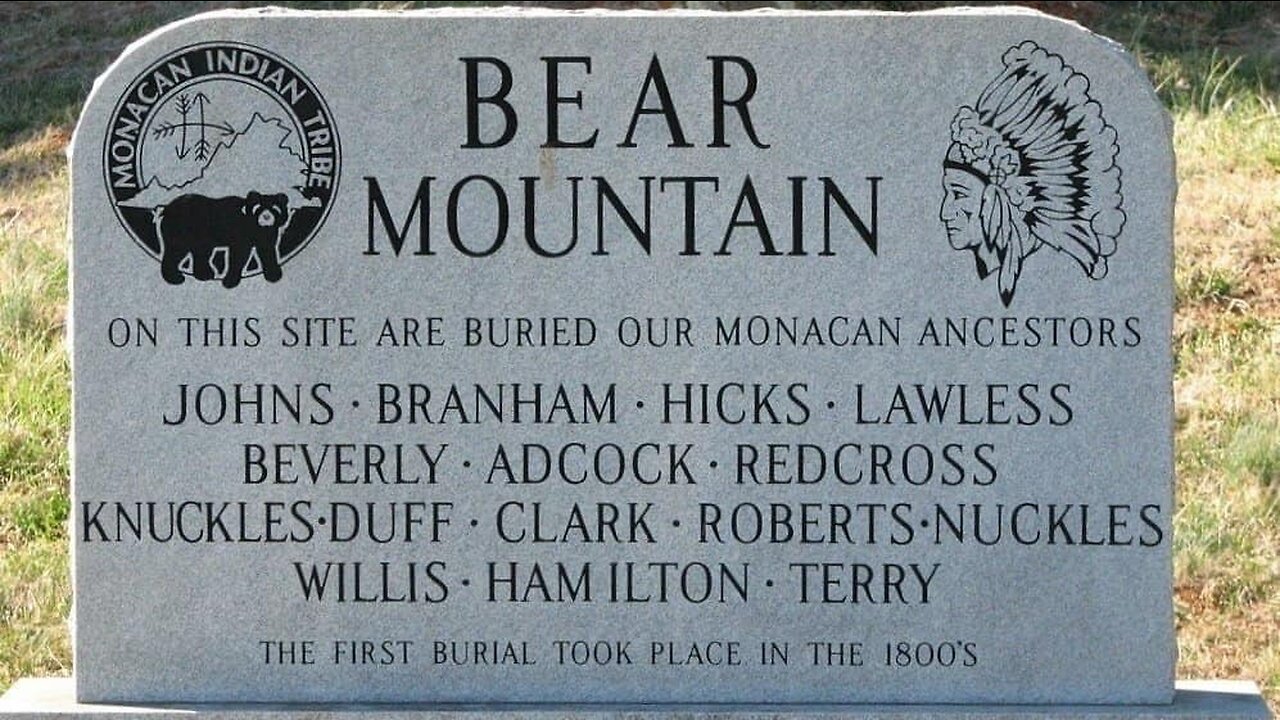Premium Only Content

Norris Francis Branham (Kwiakwi Takwax Lënuwitehe) families story is Epic.
Norris Francis Branham (Kwiakwi Takwax Lënuwitehe) families story is Epic.
So many twist and turns. Generations were interrupted. What’s the chances of my names sake being found on Monacan Tombstones as well as slaves records in the home of George Washington.
THE NORTH RAN A PLAY FOR TOTAL CONTROL OVER SOUTHERN INDUSTRY. THE SLAVES WHERE
FREED TO CRIPPLE THE SOUTH ECONOMICALLY.
The Morrill Land Act was created to balance out the Economy. By creating farming and agriculture in different regions of the Nation. After the Slaves were free the country realized they had a problem.
There were more FREE PEOPLE OF COLOR than There were WHITE PEOPLE in the U.S.
So in 1870 the Naturalization Act was created to balance out the population of FREE PEOPLE OF COLOR.
This act imported a population of people that would create the MODERN CLIMATE OF WHITE SUPREMACY. Nations who had generally been mistreated by other more dominant nations in Europe where now classified as FREE WHITE PERSONS. But the reality is those people where closer to what we call POOR WHITE TRASH. This is whom our Modern Issues of Race and Racism started with.
Those Poor Whites who are now FREE WHITE PEOPLE, became the oppressors that they themselves were fleeing Europe From.
1861 American Civil War. Union vs Confedrates
1862 Morrill Land Grant Act.
1863 Emancipation Proclamation
1870 Naturalization Acts
Now you have a Country full of Free People of Color who own Land.
Versus these newly Imported FREE WHITE PERSONS who are actually POOR WHITE TRASH. The poor whites grew jealous of the Free People of Color who owned farms and were skilled laborers.
Jobs where scarce for the POOR FREE WHITES while the FREE PEOPLE OF COLOR and even the FORMER SLAVES where highly skilled workers.
This is the climate that created hate groups like the KKK. Many of these organizations began as Unions designed to create jobs for these Poor Free Whites who lacked the skill to get hired.
I think we know the rest of the story.
The Morrill Land-Grant Acts are United States statutes that allowed for the creation of land-grant colleges in U.S. states using the proceeds ... Signed into law by President Abraham Lincoln on July 2, 1862.
Other short titles: Land-Grant Agricultural and Mechanical College Act of 1862
Long title: An Act donating Public Lands to the several States and Territories which ...
Effective: July 2, 1862
Public law: Pub.L. 37–130
January 1, 1863
President Abraham Lincoln issued the Emancipation Proclamation on January 1, 1863, as the nation approached its third year of bloody civil war. The proclamation declared "that all persons held as slaves" within the rebellious states "are, and henceforward shall be free."Jan 28, 2022
https://www.archives.gov
› exhibits
The Naturalization Act of 1870 (16 Stat. 254) was a United States federal law that created a system of controls for the naturalization process and penalties for fraudulent practices.
https://en.m.wikipedia.org
› wiki
Naturalization Act of 1870 - Wikipedia
Congress went further by amending naturalization requirements in 1870 and extending naturalization eligibility to "aliens being free white persons, and to aliens of African nativity and to persons of African descent."3 The 1870 revision of §2169, U.S. Revised Statutes, laid the foundation for future confusions
March 26,1790 image below
Lenape Tribes of lower Manhattan
ENOUGH WITH THIS DELAWARE MOOR CLAIM. THEY WERE SHIPWRECKED SAILORS FROM SPAIN. NOT INDIGENOUS AMERICANS. CUT THE MIS-INFORMATION OUT. THEY EVENTUALLY GREW TO 3 to 400 PEOPLE. THEY ARE NOT TRIBAL PEOPLE NOR DID THEY HAVE ANYTHING TO DO WITH TRIBAL GOVERNMENTS.
PILATES FLOW, STOP STRETCHING.....
THE LENAPE ORIGINS OF AN INDEPENDENT AMERICA: THE CATALYST OF PONTIAC’S WAR, 1763–1765
In the wake of the Seven Years’ War in North America, the costly British triumph seemed complete. Thus, when a coda to the Seven Years’ War erupted in the interior of North America, it came as an unwelcome shock to the British Empire. War broke out anew, nominally led by the Ottawa chieftain Pontiac, who gathered members of many tribes in a combined war against British presence in the Great Lakes and Ohio region. One of the tribes that participated in what historians have called Pontiac’s Rebellion or Pontiac’s War was the Lenape, who laid an informal siege to Fort Pitt in western Pennsylvania. Lenape attacks disrupted settlement in central and western Pennsylvania and cut off trade and contact with the fort for several months, until a relief expedition under Col. Henry Bouquet won the battle of Bushy Run in August 1763 and temporarily dispersed Lenape forces, relieving the siege. Even then, the war dragged on in a stalemate that stretched into 1765.
Although many historians have focused on Pontiac himself, Pontiac’s War was as much a Lenape war as Pontiac’s conflict. While the Lenape had signed the Treaty of Easton in 1758, renouncing their alliance with the French and concluding peace with the British, they renewed the war in 1763, responding to direct threats to their territory, disruption of their economy due to British stinginess and pettiness, and a spiritual movement that stressed a pan-Indian creation and sought revival in rejection of English corruption. In the wake of Gen. John Forbes’s 1758 expedition against Fort Duquesne, which resulted in the French retreat from the Ohio country, Anglophone settlers poured into central and western Pennsylvania, displacing the Lenape and other nations or amalgamated groups. Rather than leaving the strategic Forks of the Ohio, the British rebuilt Fort Duquesne, calling it Fort Pitt. The Lenape thus faced a repetition of the circumstances that had pushed them into western Pennsylvania in the first place. British commander-in-chief Jeffrey Amherst’s restrictive trade policies and unwillingness to remove British forts such as Fort Pitt in the wake of British triumph over the French also rankled. Not only did the Delawares and most other nations depend on European trade goods, but the customary “gifts” of diplomacy also represented a kind of tribute in return for permission to occupy Native land. Amherst abruptly stopped the practice of gift giving and restricted trade of such essentials as ammunition and guns, believing it would reduce the chance of Indian hostilities if Natives were unable to stockpile weaponry.[1]
Perhaps most important in the Lenape decision to instigate Pontiac’s War was the spiritual dimension of resistance to Europeans preached by the Delaware prophet Neolin. Neolin’s message of spiritual renewal and resistance through eschewing European temptations such as alcohol and trade goods inspired Pontiac himself and suffused his orations, melding the spiritual and political dimensions of his war into a message that united tribes of the Eastern Woodlands and the Great Lakes regions in a common war against British authority and presence.[2] While Pontiac’s War ended by 1765, with Pontiac signing a formal peace in 1766, the conflict was crucial in the relations between Britain and her Atlantic Seaboard colonies. As part of the efforts to keep the Iroquois League in particular from joining Pontiac, George III promulgated the Proclamation of 1763, which set aside lands west of the Appalachians as an Indian reserve, forbidding further colonial settlement. Thus, Pontiac’s War and the Proclamation of 1763 together changed the balance between Great Britain and her colonies, beginning the series of tensions leading to American independence.
The Eighteenth-Century Lenape: Unwilling Vassals of the Iroquois
When William Penn arrived to settle and administer his grant of Pennsylvania in 1682, the Lenape Indians whom he encountered had already had nearly two centuries of contact with Europeans, dating to an initial encounter with Giovanni Verrazano in 1524.[3] The name Lenni Lenape means “the Original People,” as many Indian cultures have named themselves.[4] The Lenape were a collection of small matrilineal family groups speaking two related Algonquian languages, Munsee and Unami. Comprised of three major clan groups, they inhabited the area of present-day New Jersey, southeastern New York, Eastern Pennsylvania, and northern Delaware.[5] Early English settlers called the river at the center of Lenape homelands the Delaware River, after the first governor of the Jamestown colony, Lord De La Warr, and thus called the people who lived along the river the Delawares, a name the Munsees and Unamis gradually adopted for themselves.[6] Lacking the political unity of the Iroquois League and living closer to the Atlantic coastline, the Lenape suffered more rapid loss of their lands than the Iroquois to Dutch, Swedish, and English settlers.[7] By the late seventeenth century, most Lenape had moved out of New Jersey, resettling in eastern Pennsylvania, with some groups moving into central Pennsylvania and the Ohio River country. By the end of the seventeenth century, the Delawares were “props” to the Iroquois League, and generally had the appellation “nephews,” reflecting subordinate kinship status, or “women.” This latter epithet was not necessarily originally pejorative; it meant that the Delawares were peacemakers who left war to their allies, the Iroquois.[8] In many Eastern Woodlands cultures, while gender roles were usually separate, women had important, valued, and influential roles that European settlers did not acknowledge. Lenape society was both matrilineal and matrilocal—the husband married outside his clan and lived with his wife’s family, meaning that the Lenape were generally monogamous and valued women’s power and contributions.[9]
Pennsylvania and New York forged diplomatic alliances with the Iroquois League, thanks to the influence of traders and Indian agents who had lived among the Iroquois, were sympathetic to their interests, and respected their power.[10] The Iroquois set Half-Kings, or diplomatic viceroys, over many of the amalgamated Indian communities in central Pennsylvania and the Ohio country. By the middle of the eighteenth century, the Six Nations wielded a heavy hand in dealing with the Lenape. This dominance manifested most nakedly in the so-called “Walking Purchase” of 1737, in which William Penn’s sons, John and Thomas, secured tens of thousands of acres along the Delaware River in eastern Pennsylvania by means that were dubious, at best.[11] When the Lenape protested what they considered fraud, the Iroquois ratified the purchase and upbraided the Lenape, who they claimed had no right to dispose of the land at all. As the Onondaga Chieftain Canasatego scornfully informed the Delawares at a public council concerning the Walking Purchase and Lenape refusal to leave the lands in 1742, “You ought to be taken by the Hair of the Head and shak’d severely . . . We conquer’d You, we made Women of you, you know you are Women, and can no more sell Land than Women.”[12] The Lenape bowed to the Iroquois ultimatum and moved westward, but the cession of these lands rankled and sowed the seeds of discord a generation later.
The Promise of Peace—Easton, 1758
After the failure of Edward Braddock’s 1755 campaign to capture Fort Duquesne at the outset of the Seven Years’ War, the Lenape defied the Iroquois’ initial neutrality and allied with the French. Raiding the frontiers of Pennsylvania and into New Jersey, they terrorized many British citizens and aided the French in their pursuit of dominion over the Ohio country. Yet at the height of the struggle for the North American continent, a conference between representatives of the British Crown, the Colony of Pennsylvania, the Province of New Jersey, the Eastern and Western Lenape, the member tribes of the Iroquois League, and numerous other Indian nations convened at Easton, Pennsylvania, in October 1758. Following inconclusive negotiations between the eastern Lenape leader Teedyuscung and the Pennsylvania government in 1756 and 1757, this conference brought peace for the Lenape and many other Iroquois vassals who had been fighting for the French. After an initially rocky beginning, marked by drunken outbursts by Teedyuscung, the delegates forged a peace that not only reshaped both Pennsylvania and New Jersey land claims, but also altered the relationship between the Lenape and their nominal overlords, the Iroquois.[13] Speaking for the Six Nations and their “nephews” the Delawares, the Seneca chieftain Tagashata declared peace on the part of the Lenape:
I now speak at the Request of Teedyuscung, and our Nephews the Delawares . . .
Brethren, We now remove the Hatchet out of your Heads, that was struck into it by our Cousins the Delawares . . . Our Cousins the Delawares, have assured us they will never think of War against their Brethren the English any more, but employ their Thoughts about Peace, and cultivating Friendship with them, and never suffer Enmity against them to enter into their Minds again.[14]
By the terms of the Treaty of Easton, both the eastern and western Lenape renounced their alliance with the French, guaranteed peace with the British, and formally ceded all land claims in New Jersey and Eastern Pennsylvania. In return, the Lenape received 1,000 Spanish Reales, guarantees of land in western Pennsylvania and the Ohio country, return of some land ceded without their consent by the Iroquois, and promises of limits on colonial settlement west of the Allegheny Mountains.[15] Importantly, Pennsylvania’s Gov. William Denny agreed to negotiate directly with the western Lenape, without consulting the Iroquois—effectively granting the western Lenape a renewed political independence from their former domination by the Six Nations.
The Treaty of Easton was clearly advantageous to the provincial governments of Pennsylvania and New Jersey, as well as to the British Crown. Yet while Teedyuscung was publicly humiliated and forced to reaffirm eastern Lenape subordination to the Iroquois, the Lenape also gained, at least in theory.[16] While the Delawares and their kin agreed to give up land claims to which they had lost “squatters rights” through increased Anglophone settlement, chiefly in New Jersey, Pennsylvania recognized the western Lenape claims to settlement and hunting grounds west of the Appalachians and agreed to prohibit white settlement in that area.[17]Direct negotiation with Pennsylvania, granting de facto political autonomy from the Iroquois, was also welcome to the Delawares. Although humiliated, Teedyscung could at least claim that he had secured residence for the eastern Delawares in the Wyoming Valley of Pennsylvania, together with houses built by Pennsylvania.[18]
The greatest effect of the Treaty of Easton, however, was the decisive advantage it gave to the British Army in the struggle for North America. Peace between the Lenape, other Pennsylvania Indians, and Britain ensured the success of Gen. John Forbes’s expedition against Fort Duquesne. Moving methodically through the area where Gen. Edward Braddock had met with disaster at the beginning of the war, Forbes was able to count on the neutrality of the Lenape and other tribes, and the French garrison defending Fort Duquesne lost its most valuable protection. Faced with overwhelming odds, the French blew up the fort and retreated, giving the British control of the Ohio country.
The Betrayal of Peace, 1758-1763
The Lenape peace at Easton, however, sowed the seeds of future war. With the threat of Indian raids removed, Forbes’s triumph in the Ohio country gave both a physical and psychological incentive to additional Anglophone settlement. As part of his march into the Ohio country, Forbes built a military road from Philadelphia out to the ruined Fort Duquesne. With the French retreat, he secured the strategic position at the Forks of the Ohio with a larger, more strongly built fort that he named Fort Pitt in honor of Britain’s prime minister. Despite British promises that the British occupation of western forts was a temporary war measure, Amherst also maintained garrisons in forts in the Great Lakes region and western Pennsylvania. These forts aroused instant opposition, as Indian leaders immediately protested British maintenance, rebuilding, and strengthening of installations such as Fort Pitt.[19]
Seeing rich land that had previously been closed to them by threats of Indian violence, settlers poured into the Wyoming Valley and the Ohio country beginning in 1759, displacing the Delawares in lands the Lenape had thought secured by the peace in 1758. Many land speculators from Connecticut, believing that their royal charter gave them land claims in Pennsylvania, risked conflict with both the Lenape and the Province of Pennsylvania. Forming the Susquehanna Company and moving into the Wyoming Valley, they crowded out the eastern Delawares living there. When Teedyuscung protested, travelling to Philadelphia to complain to the governor in late 1762, he paid with his life. In April 1763, he died in a suspicious house fire; many historians agree Susquehanna Company agents likely set the late-night blaze.[20] Nearly all of the Delaware settlement burned. Within weeks, settlers under the auspices of the Susquehanna Company moved into the Wyoming Valley. Similar patterns of settlement went on elsewhere in western Pennsylvania. Professor Colin Calloway describes an unprecedented wave of emigrants to the English colonies in general and to western Pennsylvania in particular.[21] In addition to the Susquehanna Company, other groups of land speculators like the Ohio Company of Virginia resumed their sales of land to which they had dubious title, encouraging even more emigrants. Forbes’ military road served as a physical highway into the West of Pennsylvania. It offered settlers a direct line of travel between military installations that rapidly became local centers of trade, and despite the promises made by Governor Denny at Easton and efforts by British leaders like Col. Henry Bouquet at Fort Pitt to root out squatters, the Anglophone population west of the Alleghenies grew rapidly.[22]
Indian discontent with Anglophone settlement bubbled to the surface as the Seven Years’ War concluded. Even by the fall of 1762, well before Pontiac’s War broke out, officials like Governor Hamilton of Pennsylvania, Governor Denny’s successor, wrote to Sir William Johnson, Indian Agent for the Northern Colonies, speaking about the potential for war if settlement proceeded.[23] Hamilton’s fears were far from the only evidence that the Lenape in particular intended to resist white encroachment on their lands. Trader and British Indian Agent Alexander McKee, one of Johnson’s subordinates, recorded at the beginning of November 1762 that Delaware Indians were circulating belts of wampum among the Seneca, Shawnee, Ottawa, Chippewa, and Pottawatomie, calling for a general war against the English.[24] As the Delawares were circulating war belts even before the Treaty of Paris ended the Seven Years’ War and confirmed the French cession of North America, Pontiac’s War was in fact from the outset a Lenape campaign as much as the brainchild of Pontiac.
Amherst’s Restrictive Policies and the Spark of War
British Commander-in-Chief in North America Jeffrey Amherst unintentionally did a great deal to instigate the renewed outbreak of war through his callous disregard of Indian interests and his insensitivity to Indian diplomacy. Amherst was contemptuous of Indians, even those who had been British allies throughout the Seven Years’ War.[25] As that war drew to a close in North America in 1761, he issued orders limiting the practice of gift-giving in Indian diplomacy. He also attempted to restrict trade with Indian nations, particularly forbidding the sale of firearms, gunpowder and lead.[26] This policy may have been partially a reaction to the generous practices of Sir William Johnson and his deputies, such as the trader and agent George Croghan, who secured Indian alliances through the liberal distribution of gifts. Amherst and Johnson disliked one another intensely, and their rivalry may have been a factor in Amherst’s disdain for Johnson’s diplomacy.[27]
The effects of Amherst’s restrictions undoubtedly helped drive the Lenape to renewed war. Over the course of the seventeenth and eighteenth centuries, nations such as the Iroquois and their vassals, including the Lenape, had grown adept at playing European powers against one another and extracting gifts from their agents as a sign of respect. Northeastern Indian tribes regarded the distribution of gifts as part of the reciprocal relationship of trade and alliances, a sign by Europeans that Indian presence and concerns mattered. The presents served as a sign of respect, an annual tribute for European presence on unceded lands.[28] Gift giving also helped to uphold the authority of leaders friendly to diplomacy with Europeans, as Indian agents typically gave gifts to principal chieftains, who then distributed the presents to those who followed them.[29] Most importantly, Amherst’s restrictions on both trade and gifts meant that the Lenape and Shawnee had difficulty obtaining the goods they needed to survive. With the collapse of the French Empire in North America, tribes were no longer able to exploit the rivalry between the English and the French. At the same time, prices of furs plummeted as a glut of hides saturated the British markets.[30] The shift in global trade angered Indians, who regarded the change in prices as the greed of Anglophone traders and complained bitterly—with much justification—of being cheated just when the option of taking their hides elsewhere had disappeared.[31] Just as the Lenape needed more hides or furs to obtain the goods on which they had come to depend, Amherst forbade trade in the firearms, powder, and lead they needed to harvest game. As Croghan warned Bouquet in December 1762, the Lenape saw Amherst’s policy as evidence that the British planned to attack them:
They say, they never Intended to make War on the English, but Say it’s full time to prepare to Defend themselves & their Country from Us, who they are convinced Design to make War on them; They say, if We did not Intend that We would not Prohibit the Sale of as much Powder & Lead as would Supply them to Hunt with, not Refuse their Warriors Powder & Lead, and other Necessarys . . . They Interpret the General’s Frugality in Lessening the Expence of Presents in a Design of Revenging what is past . . . I am of Opinion it shall not be long before We have some Broyles with them.[32]
Croghan explicitly cited Amherst’s ban on presents in discussing the Delaware plans for war. Bouquet endorsed Croghan’s message and sent it to Amherst and Johnson, so there were multiple reports of Lenape unrest and discontent well before the final French cession of North America. Amherst’s failure either to modify his policies or at least to warn British forts of the distinct possibility of war indicates a signal military failure. Historian James Flexner has stated that the conflict should, in fact, be known as “Amherst’s War,” as his policies were instrumental in bringing it about.[33]
A Spiritual Dimension to the Struggle: the Delaware Prophet Neolin
While many historians have focused on the military, economic, and political causes of Pontiac’s War, recent scholarship by contemporary historians such as Daniel Richter, Fred Anderson, and Gregory Dowd has focused as well on the spiritual dimension of the conflict.[34] Even before the Seven Years’ War, a century of land dispossession had had a catastrophic effect on Indian communities. Many Indians in the Ohio region were living in mixed intertribal communities, with cultures such as the western Lenape and Shawnee blending together with admixtures of other groups.[35] Their world and traditions in tatters, many Indians were receptive to religious messages that stressed Indian renewal through spiritual purification. A number of prophets emerged during the final years of the Seven Years’ War, the most influential being Delaware spiritual leader Neolin, known as the Delaware Prophet. Neolin was one of many “nativists” interested in spiritual renewal; many lesser-known prophets spread a similar message in the 1750s and 1760s. Among the Lenape, there were at least three other “prophets” who claimed visions from the “Master of Life,” who bid them to preach abstinence from alcohol and stressed the joining of all Indians in a spiritual and moral alliance.[36] In a time of upheaval and change brought about by war and displacement, this message resonated both in the polyglot communities of the Ohio country and among the various tribes who had cooperated against the British.[37]
Like his predecessors, Neolin blended elements of Lenape tradition and Christianity, as well as borrowed traditions from other cultures. He did not preach a simple return to an imagined ideal past, but rather a pan-Indian movement that stressed ritual purification and rejection of the corruption of European, particularly English, temptations.[38] Neolin stressed the separate creation of Indians, claiming that the Master of Life had created all Indians as brothers, distinct from Africans and particularly from Europeans. Placing the blame for Indian losses of land, culture, and population on the Indians themselves, Neolin preached that Indians must regain their spiritual power through rejection of European innovations and an embrace of his vision granted by the Master of Life. He stressed purification through purging, including an emetic known simply as the “black drink.” To regain spiritual power and cleanse themselves of contamination, those who followed the Master of Life were obliged to renounce alcohol, give up polygamy, gradually decrease dependence on trade, and eventually relearn the use of bows and arrows for hunting, rejecting the use of firearms, along with other English innovations such as flint and steel for firestarting.[39]
Neolin’s message opened an avenue to common resistance against the British and the settlers in western Pennsylvania. First appearing in 1761 or 1762, the implicit antagonism and conflict with British colonists of his teachings resonated with Lenape villages in the Ohio country along the Susquehanna, and quickly spread to other communities and tribal groups. By April 1763, the Ottawa chieftain Pontiac discussed the ideas of Neolin at a gathering of Indians near Detroit. According to historian Jon Parmenter, the war belts that Pontiac laid before the Ottawa, Ojibwa, and Pottawatomie in calling for a unified war against the English came from the Delawares, perhaps incensed at the death of Teedyuscung.[40] A passionate adherent of the French cause in the Seven Years’ War, Pontiac absorbed the teachings of Neolin and allied spiritual and physical messages of renewal to resist English encroachment. Rather than cynically employing Neolin’s message, Pontiac was a disciple of the Delaware Prophet. He urged war against the English both to restore Indian power and to encourage the French to return and resume the struggle against the British.[41]
The Lenape Participation in Pontiac’s War 1763-1765
Traditionally, historians have emphasized Pontiac’s European-style siege of Fort Detroit in speaking of the war, giving his name to the war and the beginning of the conflict to his May 9, 1763, attack on the fort. Yet Pontiac was hardly in control of the Indian forces allied against Anglophone military installations and settlements. While Detroit did form a major front, Indians across the Great Lakes and Ohio River Valley acted more or less independently, tied more by a spiritual alliance than by the coordination of any one leader. In a series of attacks, groups of Indians from a wide array of cultures destroyed or forced the British Army to abandon nine forts, butchering many of the garrisons. During 1763 and 1764, the attacks killed approximately four hundred British soldiers and two thousand Anglophone settlers.[42]
Having in many ways instigated the conflict, the Lenape were an integral part of the fighting. Delaware warriors attempted to take Fort Pitt, cutting off most communication with the fort and attacking settlers throughout the Ohio Country. The fort was largely cut off from June through August 1763, while Delaware, Shawnee, Mingo, and allied war bands ravaged settlements throughout western Pennsylvania. In late June, at the height of the siege of Fort Pitt, Capt. Simon Ecuyer, the fort’s commander, met with two Lenape chieftains who offered to allow the garrison to depart in peace but, not trusting their words, Ecuyer refused. At the conclusion of negotiations, “Out of our regard to them, we gave them two Blankets and an Handkerchief out of the Small Pox Hospital. I hope it will have the desired effect.”[43] In this regard, Captain Ecuyer anticipated the orders of General Amherst, who wrote to Colonel Bouquet in July, “Could it not be contrived to Send the Small Pox among those disaffected Tribes of Indians? We must, on this occasion, Use Every Strategem in our power to Reduce them.”[44] While Amherst’s willingness to use biological warfare against the Indians seems revolting today, it is more difficult to blame Captain Ecuyer. As Croghan wrote to Johnson, the Lenape were calling on Ecuyer to surrender, telling him that all other forts in the West had fallen, and a trader reported the garrison at Fort Pitt was receiving fugitives who spoke of the destruction of the forts at Sandusky and Presque Isle.[45] Based on reports of the massacre of British garrisons, Ecuyer and those in Fort Pitt were justified in an imminent fear of death, perhaps torture, if the Lenape were successful in taking the fort. As smallpox had already broken out in the overcrowded fort, Ecuyer had some justification in attempting anything that would harm his enemies. Smallpox did spread through the Lenape and other tribes engaged in the conflict that summer, as well as through the British, but whether Ecuyer’s “gifts” caused the epidemic is unknown.[46]
In response to the Lenape siege of Fort Pitt, Amherst scrambled to put together a relief force. Many regiments had been sent to the West Indies in the last years of the war, and he had relatively few troops on hand.[47] Nonetheless, he cobbled together forces of approximately four hundred sixty soldiers under Henry Bouquet and sent the expedition to relieve Fort Pitt, as well as to chastise the Indians (a force sent to relieve Fort Detroit reached the fort, but was then wiped out in an ill-advised sally against Pontiac’s camp).[48] Leaving Philadelphia in mid-July, Bouquet’s expedition followed Forbes’s road toward Pittsburgh, leaving small detachments to garrison forts along the way in 1758. At Edge Hill, near Bushy Run Creek, about twenty-five miles from Fort Pitt, Bouquet’s forces marched into an ambush by a coalition of Lenapes, Mingos, Shawnees, Wyandots, Ottawas, and Miamis. After desperate fighting, Bouquet sprung a trap of his own; two companies feigned a panicked retreat and counterattacked when the warriors pursued them. Bouquet’s reports to Amherst put a good face on the action, and Amherst recorded it in tones that indicated he regarded the encounter as a decisive victory.[49] Earlier historians agreed with Amherst and Bouquet’s estimation, even calling the battle a “signal victory.”[50] Modern historians, however, point out that while Bouquet did drive off the attackers, he lost approximately a quarter of his men, most of his horses, and had to destroy many of the provisions he had brought for the relief of the fort.[51]
Although Bouquet’s expedition made it to Fort Pitt, evacuated civilians, and lifted the siege, the victory did not mean the end of violence in the region. In October 1763, Teedyuscung’s son Captain Bull destroyed the Susquehanna Company settlement in the Wyoming Valley. This revenge for Teedyuscung’s death took a gruesome form inspired by Neolin’s rejection of British goods—dead men had their eyes pierced with awls, and one woman’s body was found with the remains of red-hot iron hinges placed in her hands.[52] In December 1763, a group of western Pennsylvanians calling themselves the Paxton Boys murdered six peaceful Indians, Moravian Christians living in the town of Conestoga. They then slaughtered fourteen more who had taken refuge in Lancaster, Pennsylvania. Some of the Paxton Boys had been among those who buried the mutilated bodies at Wyoming, and they revenged themselves on any who resembled the Wyoming attackers.[53] Declaring that all Indians were enemies in an ironic echo of Neolin’s “separate creation,” they marched on Philadelphia, both to kill Indians sheltering there and to coerce or attack the Pennsylvania Assembly, which they believed had more concern for Indians than for Anglophone settlers’ interests and safety. They were convinced to disband and return home only when Benjamin Franklin met with them and promised to address their concerns in the assembly.[54] Unfortunately, the conflict in Pennsylvania and throughout the colonies became a race war.
By the beginning of 1764, the war settled into a general stalemate. At Detroit, Pontiac broke off his siege in at the end of October 1763, when an emissary from the French commander in Illinois brought definitive news of the Treaty of Paris, informing Pontiac that there would be no French attempt to reconquer the territory lost in the Seven Years’ War. Disease and the difficulties of holding a coalition took their toll on the Indian alliance.[55] Without the counterweight of the French, tribes were forced to depend on trade with the British. The diplomacy of Sir William Johnson, who persuaded the Six Nations of the Iroquois to convince the Seneca to repudiate their ties to Pontiac and send messages to their vassal tribes to desist from attacks also played a role in damping down the conflict. British expeditions in 1764 into present-day Ohio and Illinois met former enemies who were now willing to swear peace, affirming themselves as part of the Covenant Chain that linked the British and their allies.[56] By 1765, the war was generally over, although Pontiac himself did not sign a formal peace and declare himself an ally of the British until July 1766.[57]
The Royal Proclamation and the Long-term Effects of the Conflict
Alarmed by the renewed outbreak of violence in North America, the British Crown responded in late 1763 with an attempt to separate the contending forces on the frontiers. Influenced in part by the advocacy of Sir William Johnson, George III promulgated the Royal Proclamation of 1763. This edict essentially extended the policy agreed upon in Pennsylvania at the Treaty of Easton in 1758; it declared a line running through the Appalachian Mountains beyond which colonial settlement was prohibited. The West was an Indian preserve, “To reserve under our Sovereignty, Protection, and Dominion, for the use of the said Indians . . . all the Lands and Territories lying to the Westward of the Sources of the Rivers which fall into the Sea from the West and North West as aforesaid.”[58] Although the line was well-intentioned, American colonists viewed the restriction as a betrayal of the blood they had spilled in the war and an attempt to keep them from the spoils of victory. The Proclamation was unrealistic from the outset, and the declaration of the Crown to become the protector of the Indians rankled colonists who had come to believe that all Indians were enemies to be exterminated, rather than equals with their own concerns and interests.[59] The depleted state of the British treasury in the wake of Pontiac’s War also induced British Ministers to attempt to lay taxes on the American colonies. American Provincials protested, evaded, and defied British laws, no longer needing British protection from the French, irked at new taxes, and incensed by being denied access to lands they considered conquered. Tensions mounted that exploded roughly a decade later in the American Revolution.
Conclusion
While the Seven Years’ War changed the balance of power between Britain and France in favor of Britain, Pontiac’s War changed the balance of power between Anglophone colonists and Indian tribes, as well as between Britain and her American provinces. At the heart of the struggle were the Lenape, led by the spiritual leader Neolin. Betrayed by British failure to keep promises guaranteed at the Treaty of Easton, pressed by unchecked colonial settlement on lands reserved for them, and suffering under restrictions on trade imposed by the collapse of the French Empire and Amherst’s restrictions on the necessities of their economy, the Lenape began sending out war belts, coupled with a spiritual message of separate creation and resistance. By the time the conflict sputtered to an end, the British Empire had assumed the role of protector of the very tribes who had been murdering British subjects, prohibiting settlers from gaining title to lands they considered theirs in the wake of French defeat. Thus, the Lenape instigation of Pontiac’s War was at the root of both racial war and eventual colonial rebellion. The founding of the United States was, in part, an inadvertent Lenape creation.
[1]Colin G. Calloway, The Scratch of a Pen: 1763 and the Transformation of North America (New York: Oxford University Press, 2006), 69.
[2]Gregory Evans Dowd, “Thinking and Believing: Nativism and Unity in the Ages of Pontiac and Tecumseh,” American Indian Quarterly. Summer 1992, Vol. 16, Issue 3, 309-335.
[3]Gregory Evans Dowd, The Indians of New Jersey (Trenton, NJ: New Jersey Historical Commission, Department of State, 2001), 31.
[4]Paul A. W. Wallace, Indians in Pennsylvania (Harrisburg, PA: The Pennsylvania Historical and Museum Commission, 1975), 16.
[5]Dowd,Indians of New Jersey, 9.
[6]Wallace, Indians in Pennsylvania, 16.
[7]Dowd,Indians of New Jersey, 47, 50.
[8]Wallace, Indians in Pennsylvania, 56-57. Richard S. Grimes, The Western Delaware Indian Nation, 1730-1795: Warriors and Diplomats (Lanham, MD: Lehigh University Press; copublished by The Rowman & Littlefield Publishing Group, Inc., 2017), 8-10, posits that the Lenape in southern New York became part of the “Covenant Chain” metaphorically forged by New York Governor Edmund Andros in 1677, and they allowed the Mohawks to become spokesmen for them in negotiations with English representatives.
[9]Wallace, Indians in Pennsylvania, 30-31.
[10]Fred Anderson,The Crucible of War: The Seven Years’ War and the Fate of Empire in British North America, 1754-1766 (New York: Vintage Books, 2001), 20-22. Wallace, Indians in Pennsylvania, 141-142. Conrad Weiser, George Croghan, and Sir William Johnson were all colonial English traders and diplomats who had extensive ties to the nations of the Iroquois League. They moved between European and Indian worlds and collectively had a great deal of influence both with Natives and on British and colonial Indian policies.
[11]Anderson, The Crucible of War, 22. Grimes, The Western Delaware Indian Nation, 22-23.
[12]Grimes, The Western Delaware Indian Nation, 1-2.
[13]Anderson, The Crucible of War, 276.
[14]The Minutes of a Treaty Held at Easton, in Pennsylvania, in October, 1758. By the Lieutenant Governor of Pennsylvania, and the Governor of New-Jersey; with the Chief Sachems and Warriors of the Mohawks, Oneydos, Onondagas, Cayugas, Senecas, Tuscaroras, Tuteloes, Nanticokes and Conoys, Chugnuts, Delawares, Unamies, Mohickons, Minisinks, and Wapings, Evans Early American Imprint Collection – Text Creation Partnership, University of Michigan, 8.
[15]The Minutes of a Treaty Held at Easton, 26.
[16]Anderson, The Crucible of War, 277.
[17]Daniel K. Richter, Facing East from Indian Country: A Native History of Early America (Cambridge: Harvard University Press, 2001), 192.
[18]Ibid., 200.
[19]Calloway, The Scratch of a Pen, 55.
[20]Ibid., 54. Richter, Facing East, 200. Anderson, The Crucible of War, 533-534, is less sure.
[21]Calloway, The Scratch of a Pen, 56-60.
[22]Anderson, The Crucible of War, 524-525.
[23]Albert Corey and Milton Hamilton, ed., The Papers of Sir William Johnson, Volume X (Albany:University of the State of New York, Division of Archives and History, 1951), 552.
[24]Ibid., 578-579.
[25]J. Clarence Webster, ed., The Journal of Jeffery Amherst: Recording the Military Career of General Amherst in America from 1758 to 1763 (Toronto: Ryerson Press, 1931), 174-175. Throughout the journal, Amherst refers to the Indians as “savages;” he makes disparaging comments about them and issues orders to them, as if they were subordinates, rather than independent allies (see Webster, 254, for an example).
[26]James T. Flexner, Lord of the Mohawks: A Biography of Sir William Johnson (Boston: Little, Brown, and Company, 1979), 238. See as well Richter, Facing East, 187-188, and Anderson, The Crucible of War, 455, 469-471.
[27]Flexner, Lord of the Mohawks, 200, 215-216.
[28]Calloway, The Scratch of a Pen, 67-69.
[29]Ibid., 109-110.
[30]Richter, Facing East, 178-179, mentions the decline in the importance of the British fur trade throughout the mid-eighteenth century in the northern colonies, exacerbated by the growth of the Florida fur trade beginning in 1763.
[31]Flexner, Lord of the Mohawks, 238-239.
[32]Corey and Hamilton, The Papers of Sir William Johnson, 597 (spelling as in source).
[33]Flexner, Lord of the Mohawks, 255.
[34]Francis Parkman, History of the Conspiracy of Pontiac and the War of the North American Tribes against the English Colonies after the Conquest of Canada (New York: Macmillan, 1929), 114-115, and Flexner, Lord of the Mohawks, 254, do mention a Delaware prophet, though not by name, and their treatment of Neolin seems incidental to their discussion of Pontiac’s conspiracy, as Parkman calls it. Anderson discusses Neolin’s influence, 536-538; Dowd devotes much of the first section of his book A Spirited Resistance to a discussion of Neolin and his teachings; Richter quotes him extensively through one of Pontiac’s speeches, 193-199.
[35]Dowd, A Spirited Resistance: The North American Indian Struggle for Unity, 1745-1815 (Baltimore: Johns Hopkins University Press, 1992), 23-27.
[36]Anderson, The Crucible of War, 535-536.
[37]Dowd, A Spirited Resistance, 24-25.
[38]Alfred Cave, “The Delaware Prophet Neolin: A Reappraisal,” Ethnohistory 46: 2 (Spring 1999), 266.
[39]Ibid., 271-273, 281. The Lenape were traditionally matrilineal and matrilocal, practices which tend to inhibit polygamy, but the practice may have arisen in the polyglot communities that arose in the seventeenth and eighteenth centuries, as Lenape, Shawnee, western Seneca/Mingo, and other refugees formed new communities in central and western Pennsylvania and as far west as present-day Ohio.
[40]Jon Parmenter, “Pontiac’s War: Forging New Links in the Anglo-Iroquois Covenant Chain, 1758-1766.” Ethnohistory, Vol. 44, No. 4 (Autumn, 1997), 627.
[41]Dowd, “Thinking and Believing,” 309-310, states it is unclear whether Neolin himself was pro-French or more generally anti-European; therefore, whether Pontiac twisted Neolin’s message into an anti-British, pro-French form or simply repeated Neolin’s message is a matter of debate. Richard White, The Middle Ground: Indians, Empires, and Republics in the Great Lakes Region, 1650-1815 (New York: Cambridge University Press, 2011), 284, discusses the difficulties of translation making it unclear whether Neolin meant all whites, or merely the English. Dowd, A Spirited Resistance, 35, discusses the genuine nature of Pontiac’s belief in Neolin’s teachings.
[42]Parmenter, “Pontiac’s War,” 628.
[43]A. T. Volwiler, ed., Notes and Documents: William Trent’s Journal at Fort Pitt, 1763 (Philadelphia: Historical Society of Pennsylvania, N.D.), 400.
[44]Calloway, The Scratch of a Pen, 73. Anderson, The Crucible of War, 542-543 discusses Amherst’s desire to use biological warfare as well.
[45]Corey and Hamilton, The Papers of Sir William Johnson, 728. Volwiler, Notes and Documents, 398.
[46]Dowd, A Spirited Resistance, 36, argues that Ecuyer was responsible for the epidemic; Calloway, The Scratch of a Pen, 73, is far less certain, stating that smallpox had already broken out among Pontiac’s allies in the spring.
[47]Anderson, The Crucible of War, 541-543.
[48]Ibid., 547-550.
[49]Webster, The Journal of Jeffery Amherst, 318-319.
[50]Parkman, History of the Conspiracy of Pontiac, 266.
[51]Anderson, The Crucible of War, 549. Calloway, The Scratch of a Pen, 88, calls Bushy Run a “pyrrhic victory.”
[52]Richter, Facing East, 200.
[53]Ibid., 203.
[54]Ibid., 201-206. Apparently, Franklin reneged on his promise to address the Paxton Boys’ concerns.
[55]Calloway, The Scratch of a Pen, 74-75.
[56]Parmenter, “Pontiac’s War,” 630-635. Bradstreet exceeded his instructions and negotiated generous peace terms, insisting only on the return of all captives held by the northern Indians. This generosity actually proved useful; Bouquet’s expedition encountered Indians who were willing to negotiate rather than fight.
[57]Parmenter, “Pontiac’s War,” 638-639.
[58]George III. “The Royal Proclamation – October 7, 1763.” The Avalon Project: Documents in Law, History and Diplomacy.Yale Law School, 2008.
[59]Calloway, The Scratch of a Pen, 90-91.
-
 1:32
1:32
We The People - Constitutional Conventions
1 day agoLet the culling begin...er....continue. TRUMP Second day in office and he’s pushing a cancer vaccine
2102 -
 DVR
DVR
Benny Johnson
3 hours ago🚨BREAKING: Trump Live Right Now in North Carolina Disaster Area! Real Leader | Trump Visiting LA
46.2K75 -
 58:14
58:14
Winston Marshall
2 hours agoHollywood Insider SPEAKS OUT On Woke Hollywood & Trump’s A-List Allies | Andrew Klavan
16.2K10 -
 DVR
DVR
Game On!
2 hours agoTom Brady's BIG GAMBLE! Pete Carroll new head coach of the Raiders! | Crick's Corner
50 -
 17:26
17:26
Tactical Advisor
3 hours agoEverything New From Primary Arms 2025
2551 -
 1:55:32
1:55:32
The Charlie Kirk Show
2 hours agoThe Greatest Pro-Life President + AMA | Gingrich | 1.24.2025
51.8K20 -
 LIVE
LIVE
The Dana Show with Dana Loesch
2 hours agoThe Dana Show LIVE From SHOT Show | Day 3
1,063 watching -
 1:02:50
1:02:50
The Dan Bongino Show
4 hours agoAre You Tired Of Winning Yet? (Ep. 2408) - 01/24/2025
574K1.34K -
 48:57
48:57
The Rubin Report
1 day ago'Real Time' Crowd Stunned as Bill Maher Gives a Brutal Message to Democrats with Adam Carolla
53.9K38 -
 1:01:52
1:01:52
Dr. Eric Berg
3 days agoThe Dr. Berg Show LIVE January 24, 2025
26.4K7